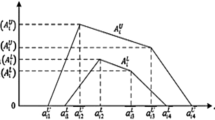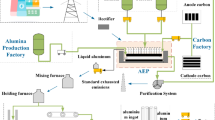Abstract
Froth flotation is a complicated process which is difficult to establish its first-principle model. Due to the fluctuations in the grade of raw ore, adaptively adjusting the set-points is extremely important in the flotation process. The inappropriate set-points easily lead to the instability of the process. This paper presents a fuzzy association rule-based set-point adaptive optimization and control strategy for the antimony flotation process without knowing the system model. Firstly, a fuzzy neural network is constructed as a soft-sensor to estimate the feed grade online because of the lack of efficient measurement equipment. Then, fuzzy association rule is used to mine the hidden relationship between the feed grade with reagent dosages and the optimal set-points. Through data mining from the quantitative database, the fuzzy inference system generates the optimal set-points. To implement satisfactory tracking performance, predictive controller is used to compute the control inputs. Because the system dynamics is unknown, long short-term memory network model is established to predict the future behaviors of the process. Finally, simulations and experiments are carried out to demonstrate the effectiveness of the proposed strategy. Compared to the manual manipulation, which is widely used in flotation processes, our control strategy achieves a better control performance, and the concentrate grades are more in line with the process requirement.








Similar content being viewed by others
Explore related subjects
Discover the latest articles, news and stories from top researchers in related subjects.References
Chai T, Zhao L, Qiu J, Liu F, Fan J (2013) Integrated network-based model predictive control for setpoints compensation in industrial processes. IEEE Trans Ind Inform 9(1):417–426
Xie S, Xie Y, Ying H, Gui W, Yang C (2018) A hybrid control strategy for real-time control of the iron removal process of the zinc hydrometallurgy plants. IEEE Trans Ind Inform 14(12):5278–5288
Qiao J, Hou Y, Han H (2017) Optimal control for wastewater treatment process based on an adaptive multi-objective differential evolution algorithm. Neural Comput Appl. https://doi.org/10.1007/s00521-017-3212-4
Kaartinen J, Hatonen J, Hyotyniemi H, Miettunen J (2006) Machine-vision-based control of zinc flotation—a case study. Control Eng Pract 14(12):1455–1466
Aldrich C, Marais C, Shean BJ, Cilliers JJ (2010) Online monitoring and control of froth flotation systems with machine vision: a review. Int J Miner Process 96(1–4):1–13
Liu JJ, MacGregor JF (2008) Froth-based modeling and control of flotation processes. Miner Eng 21(9):642–651
Ai M, Xie Y, Xu D, Gui W, Yang C (2018) Data-driven flotation reagent changing evaluation via union distribution analysis of bubble size and shape. Can J Chem Eng 96(12):2616–2626
Jahedsaravani A, Marhaban MH, Massinaei M (2014) Prediction of the metallurgical performances of a batch flotation system by image analysis and neural networks. Miner Eng 69:137–145
Lawrynczuk M (2011) Online set-point optimisation cooperating with predictive control of a yeast fermentation process: a neural network approach. Eng Appl Artif Intell 24(6):968–982
Vega P, Revollar S, Francisco M, Martin JM (2014) Integration of set point optimization techniques into nonlinear MPC for improving the operation of WWTPs. Comput Chem Eng 68:78–95
Tang Y, Peng C, Yin S, Qiu J, Gao H, Kaynak O (2014) Robust model predictive control under saturations and packet dropouts with application to networked flotation processes. IEEE Trans Autom Sci Eng 11(4):1056–1064
Li J, Chai T, Lewis FL, Fan J, Ding Z, Ding J (2018) Off-policy Q-learning: set-point design for optimizing dual-rate rougher flotation operational processes. IEEE Trans Ind Electron 65(5):4092–4102
Xie Y, Wu J, Xu D, Yang C, Gui W (2017) Reagent addition control for stibium rougher flotation based on sensitive froth image features. IEEE Trans Ind Electron 64(5):4199–4206
Coenen F, Leng P, Ahmed S (2004) Data structure for association rule mining: T-trees and P-trees. IEEE Trans Knowl Data Eng 16(6):774–778
Chen G, Liu H, Yu L, Wei Q, Zhang X (2006) A new approach to classification based on association rule mining. Decis Support Syst 42(2):674–689
Alcala-Fdez J, Alcala R, Jose Gacto M, Herrera F (2009) Learning the membership function contexts for mining fuzzy association rules by using genetic algorithms. Fuzzy Set Syst 160(7):905–921
Alcala-Fdez J, Alcala R, Herrera F (2011) A fuzzy association rule-based classification model for high-dimensional problems with genetic rule selection and lateral tuning. IEEE Trans Fuzzy Syst 19(5):857–872
Kuo RJ, Gosumolo M, Zulvia FE (2017) Multi-objective particle swarm optimization algorithm using adaptive archive grid for numerical association rule mining. Neural Comput Appl. https://doi.org/10.1007/s00521-017-3278-z
Sowan B, Dahal K, Hossain MA, Zhang L, Spencer L (2013) Fuzzy association rule mining approaches for enhancing prediction performance. Expert Syst Appl 40(17):6928–6937
Sheikhan M, Rad MS (2013) Gravitational search algorithm-optimized neural misuse detector with selected features by fuzzy grids-based association rules mining. Neural Comput Appl 23(7–8):2451–2463
Abou SC, Dao T (2009) Fuzzy logic controller based on association rules mining: application to mineral processing. In: Ao SI, Douglas C, Grundfest WS, Burgstone J (eds) Lecture notes in engineering and computer science, Springer, p 878
Zhang J, Tang Z, Ai M, Gui W (2018) Fuzzy association rule based froth surface behavior control in zinc froth flotation. Symmetry 10(6):216. https://doi.org/10.3390/sym10060216
Astrom KJ, Hagglund T (2001) The future of PID control. Control Eng Pract 9(11):1163–1175
Esfandyari M, Fanaei MA, Zohreie H (2013) Adaptive fuzzy tuning of PID controllers. Neural Comput Appl 231:S19–S28
Xie S, Xie Y, Huang T, Gui W, Yang C (2019) Generalized predictive control for industrial processes based on neuron adaptive splitting and merging RBF neural network. IEEE Trans Ind Electron 66(2):1192–1202
Ying H, Siler W, Buckley JJ (1990) Fuzzy control theory: a nonlinear case. Automatica 26(3):513–520
Xie Y, Xie S, Li Y, Yang C, Gui W (2017) Dynamic modeling and optimal control of goethite process based on the rate-controlling step. Control Eng Pract 58(SI):54–65
Zheng F, Wang QG, Lee TH (2005) Adaptive robust control of uncertain time delay systems. Automatica 41(8):1375–1383
Wu L, Su X, Shi P (2012) Sliding mode control with bounded L2 gain performance of Markovian jump singular time-delay systems. Automatica 48(8):1929–1933
Wu L, Zheng WX, Gao H (2013) Dissipativity-based sliding mode control of switched stochastic systems. IEEE Trans Autom Control 58(3):785–791
Qin SJ, Badgwell TA (2003) A survey of industrial model predictive control technology. Control Eng Pract 11(7):733–764
Abiyev RH (2011) Fuzzy wavelet neural network based on fuzzy clustering and gradient techniques for time series prediction. Neural Comput Appl 20(2):249–259
Xie S, Xie Y, Ying H, Jiang Z, Gui W (2020) Neuro-fuzzy-based plant-wide hierarchical coordinating optimization and control: an application to zinc hydrometallurgy plant. IEEE Trans Ind Electron 67(3):2207–2219
Ai M, Xie Y, Xie S, Li F, Gui W (2019) Data-driven-based adaptive fuzzy neural network control for the antimony flotation plant. J Frankl Inst 356(12):5944–5960
Zhang J, Tang Z, Liu J, Tan Z, Xu P (2016) Recognition of flotation working conditions through froth image statistical modeling for performance monitoring. Miner Eng 86:116–129
Ying H (2000) Fuzzy control and modeling: analytical foundations and applications. Wiley-IEEE Press, New York
Pizzileo B, Li K, Irwin GW, Zhao W (2012) Improved structure optimization for fuzzy-neural networks. IEEE Trans Fuzzy Syst 20(6):1076–1089
Mohanty S (2009) Artificial neural network based system identification and model predictive control of a flotation column. J Process Control 19(6):991–999
Cao B, Xie Y, Gui W, Wei L, Yang C (2013) Integrated prediction model of bauxite concentrate grade based on distributed machine vision. Miner Eng 53:31–38
Zhang J, Tang Z, Ai M, Gui G (2018) Nonlinear modeling of the relationship between reagent dosage and flotation froth surface image by Hammerstein–Wiener model. Miner Eng 120:19–28
Ai M, Xie Y, Xie S, Gui W (2019) Shape-weighted bubble size distribution based reagent predictive control for the antimony flotation process. Chemometr Intell Lab Syst 192:103821
Li M, Zhou P, Wang H, Chai T (2019) Geometric analysis based double closed-loop iterative learning control of output pdf shaping of fiber length distribution in refining process. IEEE Trans Ind Electron 66(9):7229–7238
Zhao L, Wang D, Chai T (2013) Estimation of effluent quality using PLS-based extreme learning machines. Neural Comput Appl 22(3–4):509–519
Smarra F, Jain A, de Rubeis T, Ambrosini D, D’Innocenzo A, Mangharam R (2018) Data-driven model predictive control using random forests for building energy optimization and climate control. Appl Energy 226:1252–1272
Acknowledgements
This work was supported by the National Science Fund for Distinguished Young Scholars of China (Grant No. 61725306), the National Natural Science Foundation of China (Grant No. 61751312), the Science Fund for Creative Research Groups of the National Natural Science Foundation of China (Grant No. 61621062), and the Fundamental Research Funds for the Central Universities of Central South University (Grant Nos. 2018zzts168 and 2018zzts543).
Author information
Authors and Affiliations
Corresponding author
Ethics declarations
Conflict of interest
The authors declare that they have no conflict of interest.
Additional information
Publisher's Note
Springer Nature remains neutral with regard to jurisdictional claims in published maps and institutional affiliations.
Rights and permissions
About this article
Cite this article
Ai, M., Xie, Y., Xie, S. et al. Fuzzy association rule-based set-point adaptive optimization and control for the flotation process. Neural Comput & Applic 32, 14019–14029 (2020). https://doi.org/10.1007/s00521-020-04801-1
Received:
Accepted:
Published:
Issue Date:
DOI: https://doi.org/10.1007/s00521-020-04801-1




